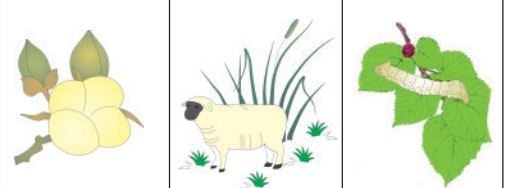7th Grade > Chemistry
FIBRE TO FABRIC MCQs
Total Questions : 116
| Page 4 of 12 pages
Answer: Option A. -> True
:
A
The hairy skin of the sheep has two types of fibres that form its fleece: (i) the coarse beard hair, and (ii) the fine soft under-hair close to the skin. The fine hair provides the fibres for making wool because it is soft enough to wear.
:
A
The hairy skin of the sheep has two types of fibres that form its fleece: (i) the coarse beard hair, and (ii) the fine soft under-hair close to the skin. The fine hair provides the fibres for making wool because it is soft enough to wear.
:
Differences: 1 Mark each
Linen: Fabric made from flax bast fibre is called linen. Linen fabric is shiny, smooth, durable and easy to wash. Like cotton, it wrinkles very easily, is cool, absorbent and is suitable for summer wear.
Jute:Like flax, jute is also a bast fibre. The fibres are short and lustrous but weaker than flax. The fibres are hairy and generally rough. It is used for making gunny bags and cords.
:
Definition: 1 Mark
Reason: 2Marks
The process of removing the woollen fleece off a sheepis known as shearing.
Shearing does not hurt the sheep because this process is similar to shaving. Only the extra layer of hair that grows above the skin is removed and the skin as such is not hurt.
:
Keratin is the chief component of wool fibres.
:
Each point: 1Mark
The advantages of polythene are as follows:
1) Polythene is tough.
2)It is durable.
3) It islight in weight.
4) It is apoor conductorof heat and electricity.
5) Itcan bemoulded in different shapes.
:
Entire cycle:3 Marks
1) The female silk moth lays about 300 to 400 eggs at a time. The eggs hatch and the caterpillars or silkworms emerge. This is called the larval stage. The silkworm feeds on mulberry leaves.
2) It secretes fine filaments from two glands on its head. The filaments are made of a protein that hardens to form silk fibres when exposed to air. The silkworm deposits filaments in layers around its body, through figure-of-eight movements of the head, forming a structure called the cocoon. The silkworm takes three to seven days to prepare the cocoon, formed by about 20-39 concentric layers of a single thread.
3) Inside the cocoon, the silkworm enters the second stage of its life (called the pupa) and then the third and final stage to become an adult moth. Silk threads are obtained from the cocoon of the silkworm.
![Click to Enlarge Image Explain The Life Cycle Of Silk Moth. [ 3 MARKS]](https://lakshyaeducation.in/quizpics/quiz/content_life-cycle-of-silkworm-2-638.jpg)
:
Each answer: 1 Mark
i) Silk is an animal fibre.
ii) Wool is the fibre that keeps our body warm.
iii) Angora goats are found in hilly regions like Jammu and Kashmir.
iv) China is the largest producer of silk.
v) Yarn is made up of fibres.
:
Identification: 0.5Mark each
Classification: 0.5 Mark each
Definition : 1 mark

Silk - It is a natural fibre obtained from cocoon of silkworm.
Jute - It is a natural fibre that is obtained from stem of jute plants.
Nylon - It is a synthetic fibre.
Polyester - It is a synthetic fibre.
Synthetic fibres are those fibres which are man-made and are obtained from various chemical processes.
:
Definition: 1 Mark each.
(i) Sericulture: The rearing of silkworms to obtain silk economically is called sericulture.
(ii) Scouring:The sheared skin with hair is thoroughly washed in tanks to remove grease, dust, and dirt. This is called scouring.
(iii) Rearing:It means taking care of herds of animals which includes feeding, grazing, breeding, etc. for economical purposes like meat and other useful products.

















